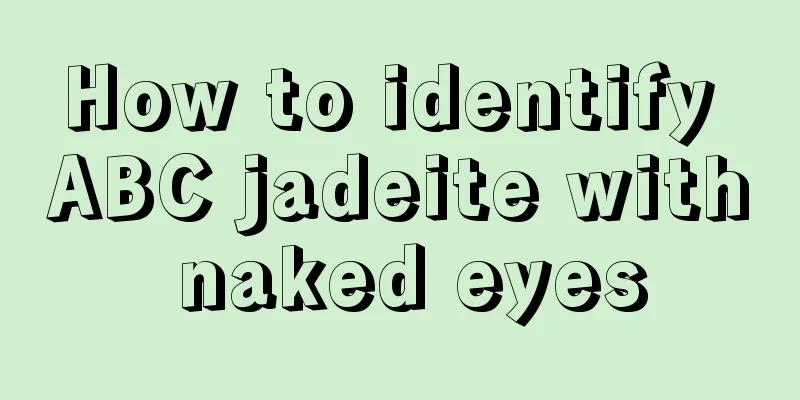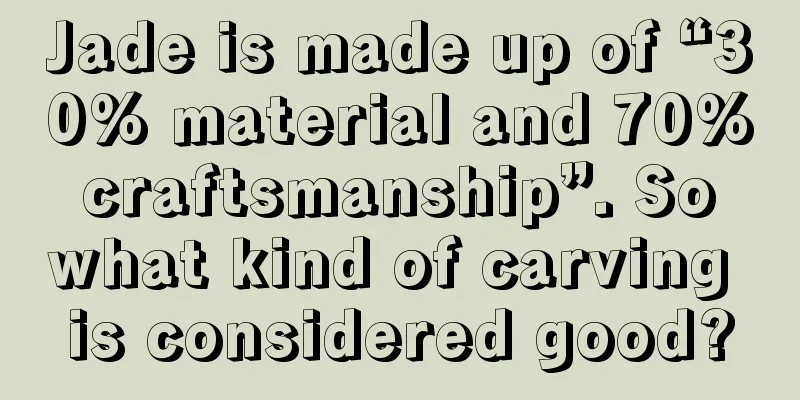How to identify ABC jadeite with naked eyes

|
Only natural jade jewelry has spiritual charm, while artificially optimized jade jewelry does not have this advantage. This article will introduce how to identify jade ABC goods using simple methods. So what are ABC jadeite goods? Grade A: Grade A is natural jade that has not been deliberately processed by humans. It has natural color and texture. Only Grade A jade is what people call the real thing. B-grade jade: B-grade jade refers to jade that has been soaked in strong acid to remove impurities and then filled with glue. Grade B jade is also called "shower" jade. Its texture is low-end jade that has been soaked in strong acid. The dirty impurities have been soaked away, but at the same time the texture of the jade has been completely destroyed. It does not have the toughness of jade, and is soft and full of gaps. In order to make it invisible on the surface, transparent epoxy resin is added to the gaps. Therefore, B-grade jadeite looks very beautiful in color and has a very transparent texture, but its price is very low, often about one tenth of the price of A-grade jadeite of the same appearance. C-grade jade: C-grade jade is jade that has been artificially dyed. Color is artificially added to the originally colorless jade. Its color is fake and it is also a fake. There are many methods of dyeing. Most of them are to heat the jade first to increase the cracks between the crystal particles, and then partially place it in the dye to allow the color to enter the jade along the cracks. The dyed colors are mostly green, purple, yellow, and red. First, you need to look at the luster of its surface. Jadeite is the brightest among many jades. Observe the cut jadeite carefully with the naked eye. The surface of the finished product has a glassy luster. When the finished product is rotated, the reflective points on the surface move quickly, which is crystal clear and flexible. The surface of A-grade jadeite has a glassy luster; while the surface of processed B-grade jadeite has a waxy resinous luster. The main reason is that the luster of A-grade jade itself after polishing is glass luster; while B-grade jade is first bleached with acid and then filled with glue and polished to show resin luster. Second, when observed with a 10x magnifying glass or microscope, the surface of A-grade jade is very smooth; while the surface of processed B-grade jade has cracks similar to chicken feet patterns. The main reasons are: A-grade jade itself has not been soaked in acid, and its surface after polishing is very smooth; while B-grade jade is first bleached with acid and then filled with glue, and its surface will show acid-etched gravel. The third is the tapping test, which mainly tests bracelets. We hang the bracelet with a thin rope and knock it with an agate stick. If the sound is crisp and has an echo, it is a Grade A bracelet. If the sound is muffled and short, it is a Grade B bracelet. The main reasons are: A-grade jade itself has not been soaked in acid, and its crystal structure is relatively dense, so it makes a crisp sound when knocked; while B-grade jade is first bleached with acid and then filled with glue, and its structure is relatively loose, so it makes a muffled sound when knocked. At the same time, the lighting method is also the easiest way to identify dyed jadeite (C goods). Dyed C-grade jadeite refers to jadeite that is artificially colored. The dyeing method is generally to use acid to wash the colorless jade with a coarse structure to remove impurities, and then bake it at a low temperature to expand the gaps between the minerals. It is then soaked in dye to allow the dye to penetrate into the gaps between the minerals along the cracks of the jade, and finally dye the jade with color. There are four types of dyed jade on the market now: lavender dyed jade, green dyed jade, expanded green dyed jade, and red dyed jade. We use a pen light to shine on the jadeite. If we see color material gathering in the gaps between the crystals and it forms a spider-web shape, we can determine that it is dyed jadeite. If we observe jadeite with a 10x magnifying glass, the color veins of A-grade jadeite are very complete, and no color vein breaks are found. If it is B-grade jadeite, it will be found that the color roots or color veins of some jadeite are unnaturally broken. The main reasons are: A-grade jade itself has not been soaked in acid, and the white or black mineral cluster inclusions (dirty colors) on the jade have not been washed away by acid; while B-grade jade is first bleached with acid and then filled with glue to wash away these dirty colors, so the color roots and color veins will be broken. fcgc66 fcpf18 |
<<: Jade can undergo such a huge change after being processed from raw stone to finished product!
>>: Inlay makes jadeite extraordinary. Aren’t you tempted by these inlaid bracelets?
Recommend
The beauty of jade inlay, a temptation you can’t resist
For oriental women, jade has a mysterious allure....
What is the meaning of fish and lotus? What does "Years of Abundance" mean in jade carving?
In the finely crafted jade carvings, we can alway...
Is jade still worth investing in today? You will understand after reading this!
Jade is a gem unique to Oriental people. It is ge...
Experts explain in detail what kind of jade is worth investing in and collecting!
Jade culture is inherited from ancient jade cultu...
How are jade bead necklaces made?
The necklace made of jade beads is round and smoo...
What are the floating flowers in jade? Is it good or bad to have floating flowers in jade?
In recent years, floating flower jadeite has been...
Jade Appreciation | 2019 "Lu Zigang Cup" Boutique Exhibition
On the morning of September 27, the 11th China Su...
Teach you how to appreciate the finest jadeite
The price of jade is ever-changing and difficult ...
Has the price of jade increased again? It is said that the best investment is the jade ring
When I wake up, I feel relaxed both physically an...
To make a fine jade product, the most important process is polishing. How to polish a jade product?
As the old saying goes, jade cannot be made into ...
High-quality blue water-bottom jadeite, the jade carving master did not carve the lucky melon, but carved it
Jade must be crafted, the craftsmanship must have...
How to choose a jade ring? You will understand after reading this article
For women, rings are also a very popular accessor...
The Origin of Jade Bracelet
Jade bracelets are so popular nowadays, but do yo...
The carving master cut the jade sheet into two pieces to carve. The finished product is really amazing.
A jade friend mailed me a palm-sized piece of jad...
Five major standards to teach you how to quickly choose jadeite!
Jadeite, the king of jades, is beautiful, unique,...









